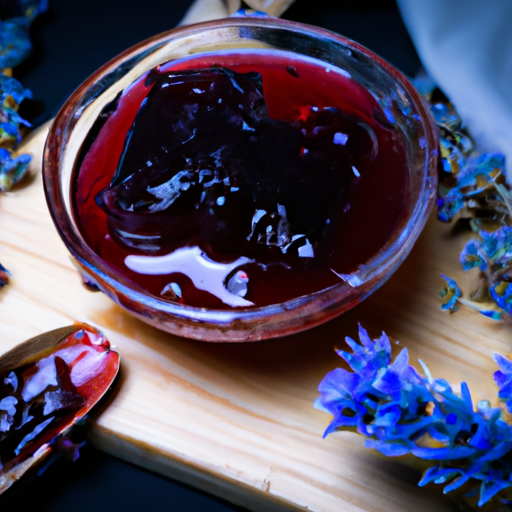The Sweet and Tangy Delight: Blueberry Jelly
If there’s one fruit that captures the essence of summer, it’s the luscious blueberry. Bursting with flavor and boasting a beautiful deep blue hue, blueberries are a beloved ingredient in a wide range of dishes. Today, let’s explore one delightful creation that perfectly showcases the vibrant taste of blueberries: blueberry jelly.
Taste that Makes your Tongue Dance
Blueberry jelly is a culinary marvel that encapsulates the natural sweetness and subtle tartness of blueberries. It offers a burst of fruity flavor with a velvety smooth texture that glides effortlessly over your taste buds. The bright blue color adds a delightful visual appeal, making it a treat for both your eyes and your palate.
Versatility at its Finest
Like other fruit jellies, blueberry jelly is incredibly versatile in the kitchen. Its tangy-sweet profile brings an exciting twist to both sweet and savory dishes. Here are a few mouthwatering ways you can incorporate blueberry jelly into your culinary adventures:
- Spread It On Toast: Start your day on a delectable note by spreading a generous dollop of blueberry jelly on warm buttered toast. The combination of the buttery toast and the fruity jelly is simply irresistible.
- Enhance Your Cheese Board: Blueberry jelly pairs beautifully with a variety of cheeses, particularly soft and crumbly ones like goat cheese or blue cheese. The creamy richness of the cheese and the tangy sweetness of the jelly create a harmonious flavor symphony.
- Dress up Desserts: Jazz up your desserts by drizzling blueberry jelly over cakes, pastries, or crepes. Its vibrant flavor and stunning color add a touch of elegance to any sweet treat.
- Glaze Your Protein: Blueberry jelly works wonders as a glaze for roasted or grilled meat. Brush it onto chicken, pork, or even salmon for a delightful twist that balances the richness of the meat with a fruity kick.
Nutritional Superstar
Beyond its delicious taste and culinary versatility, blueberry jelly also offers numerous health benefits. Blueberries are recognized as a superfood, and their essence is perfectly captured in a jar of blueberry jelly. Here are some key nutritional aspects:
- Antioxidant Powerhouse: Blueberries are packed with antioxidants, which help protect the body against the damaging effects of free radicals. These compounds have been linked to reduced risk of chronic diseases and improved overall health.
- Vitamin Rich: Blueberry jelly is a potent source of vitamins, particularly vitamin C and vitamin K. Vitamin C is essential for a healthy immune system, while vitamin K supports bone health and blood clotting.
- Fiber Boost: Blueberries are an excellent source of dietary fiber, and blueberry jelly retains much of that fiber content. Fiber aids digestion, promotes a healthy gut, and contributes to feelings of fullness, making blueberry jelly a satisfying and wholesome snack.
A Brief Journey through Time
The history of blueberries and their transformation into jelly is nothing short of fascinating. Native to North America, blueberries have been consumed by indigenous peoples for centuries. It wasn’t until the early 20th century that canning and preserving techniques allowed people to enjoy blueberries all year round.
The process of turning blueberries into jelly entails gently simmering the fruit with sugar and pectin until the mixture thickens. This preserves the natural sweetness and tanginess of the blueberries, resulting in a delightful spread that can be enjoyed at any time.
Fun Fact: Wild vs. Cultivated
Interestingly, wild blueberries are smaller in size compared to their commercially cultivated counterparts. However, they are often prized for their intense flavor, making them a popular choice among culinary enthusiasts. When selecting blueberries for your homemade jelly, either wild or cultivated ones will work perfectly, so choose based on personal preference.
So why not dive into the world of blueberry jelly and explore its myriad of culinary possibilities? Whether you’re spreading it on toast, glazing your meats, or simply enjoying it by the spoonful, blueberry jelly is a culinary masterpiece that brings a burst of fruity goodness to every dish.
Blueberry Jelly
- The origin of blueberry jelly can be traced back to North America, where blueberries are native.
- Blueberry jelly is made by crushing blueberries and then straining the juice. This juice is then combined with sugar and sometimes pectin to form a gel-like consistency.
- Blueberry jelly is commonly used as a spread for toast, English muffins, and bagels.
- It also serves as a versatile ingredient in baked goods like cakes, muffins, and pastries.
- Blueberry jelly can be used as a topping for pancakes, waffles, and ice cream.
- One of the nutritional benefits of blueberry jelly is its high content of antioxidants, particularly anthocyanins, which are responsible for the fruit’s vibrant color.
- Blueberries are also a good source of vitamin C, vitamin K, and dietary fiber, all of which are beneficial for overall health.
- Blueberry jelly is known for its sweet and tangy flavor, making it a popular choice for those seeking a balance of sweetness and acidity in their food.
- Blueberries themselves have a long history of being used for both culinary and medicinal purposes. Native Americans have been using blueberries for centuries for their healing properties.
- In terms of historical significance, blueberries held a sacred place in Native American folklore, symbolizing peace and friendship.




Use the share button below if you liked it.
It makes me smile, when I see it.